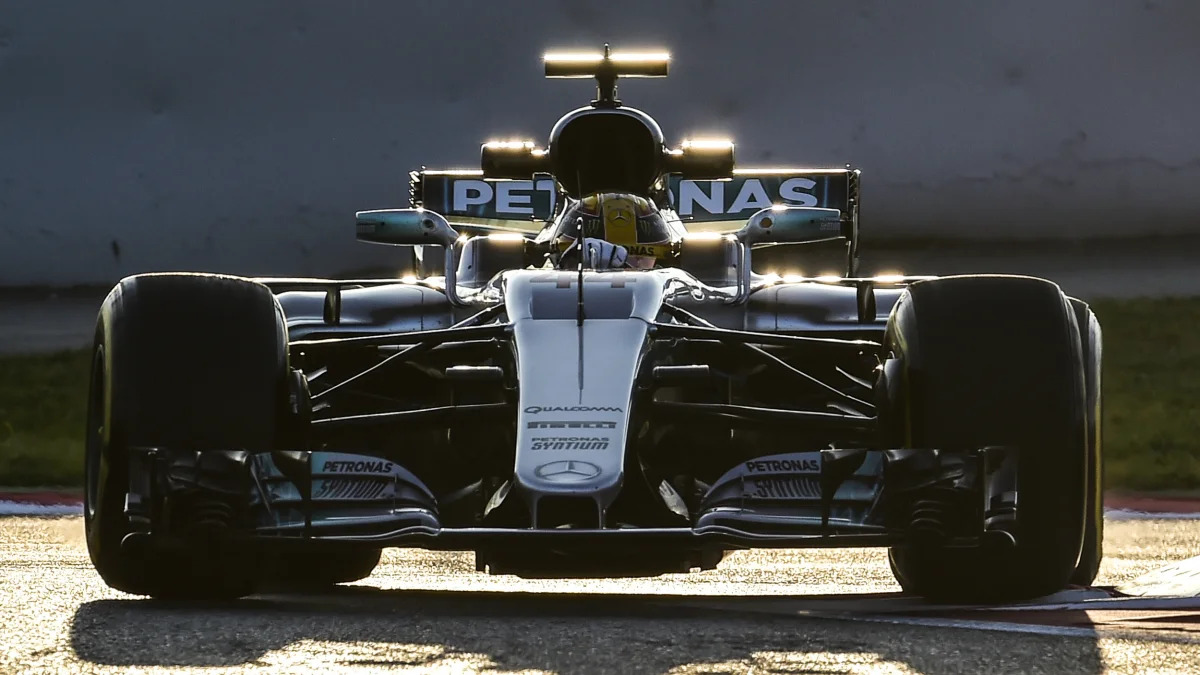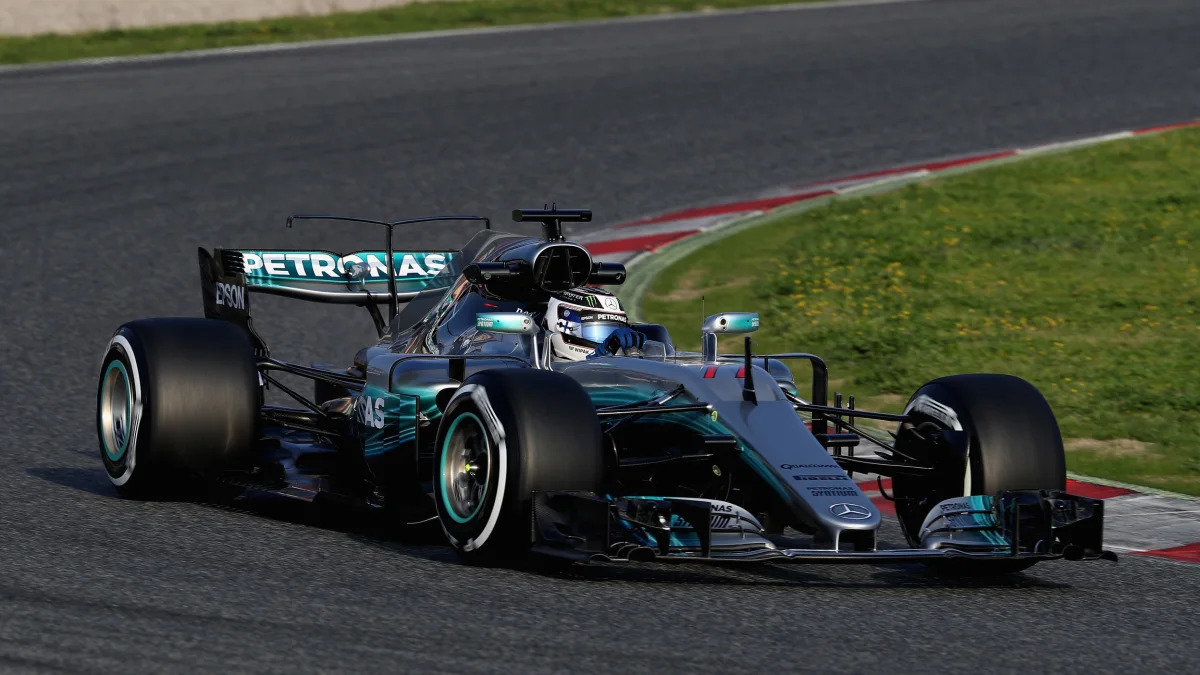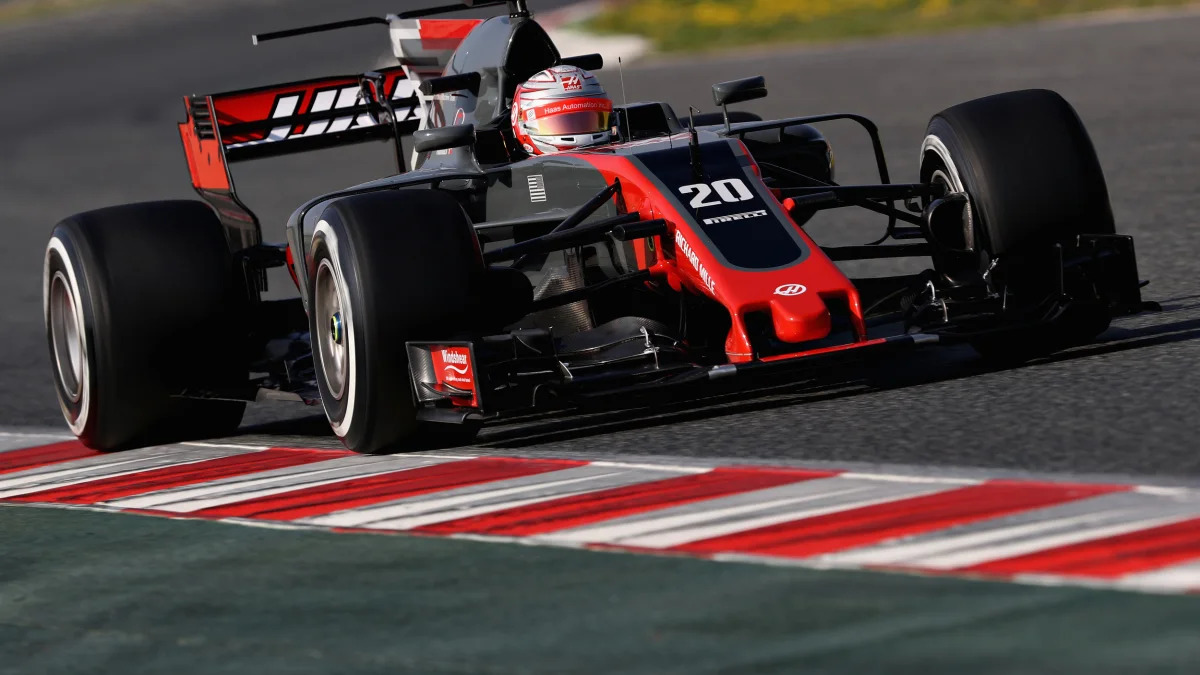2017 Formula One race cars

-

- Image Credit: JOSE JORDAN via Getty Images
New rules mean new race cars
We're just about a month away from the start of the 2017 Formula 1 season, and we're starting to get a pretty clear idea of what to expect from the 10 teams that are slated to compete. And, with a brand-new set of rules designed to make the cars faster, there's ample reason to be excited. But before we take a look at each individual vehicle, let's get a quick overview of the biggest technical changes to the cars.
Front wings are wider than before, up to 1,800 mm (70.9 in), and must have a significant rearward sweep.
Rear wings are lowered by 150 mm (5.9 in) and moved rearward by 200 mm (7.9 in).
The nose of the cars is 200 mm longer than before.
The leading edge of the barge boards – non-structural aerodynamic bits in front of the side pods and behind the front wheels – are brought forward.
Wider front and rear tires for more grip in corners.
A new minimum weight of the car (including the driver) of 722 kg. Teams are allowed to use 105 kg of fuel to account for the increase in minimum weight.
Now, let's see how each team or constructor has applied these changes to their cars for 2017. We'll display the cars in the order that they finished the 2016 season.
-
- Image Credit: Mark Thompson via Getty Images
Mercedes F1 W08 EQ Power+
The Mercedes-AMG Petronas Motorsport team was absolutely dominant last year. For 2017, a lot has changed, but it's fair to say that Mercedes is still considered the team to beat.
Take a look at the massive front wing of the Mercedes W08 chassis. It's almost ridiculously intricate, with vanes, splitters, and adjustable components galore. Also take a look at the shark fin atop the intake behind the driver. Some teams have long, flat fins, whereas Mercedes went with an abbreviated fin and a small vestigial spoiler that some other teams appear to be copying.
Considering all the turbulence caused by the larger wheels, each team's bargeboards and radiator-housing sidepods feature complex aero elements. The Mercedes W08 has perhaps the largest sidepods of the 2017 field, but with very small front inlets for cooling air.
-
- Image Credit: Mark Thompson via Getty Images
Red Bull Racing RB13
Red Bull is one of the teams that has opted for a large rear fin, as you can see in this profile image. There's another interesting detail at the very front of the car that's difficult to miss at first glance. Every other team seems to have a pointy nose for 2017, except Red Bull. The RB13 has an intake with an interesting set of internal vanes right at the front.
Unlike the complicated bargeboards on the Mercedes, Red Bull seems to have gone with a relatively simple design. Also unlike Mercedes, Red Bull's sidepods are very small and appear to hug the radiators closely. The end result is a slinky-looking machine that many hope will be able to challenge Mercedes in 2017 for podium finishes.
-
- Image Credit: Mark Thompson via Getty Images
Scuderia Ferrari SF70H
Take a close look at the rear fin of the Ferrari SF70H and you'll see a tiny rear wing, similar to the one seen on the Mercedes entry for 2017. There's a loophole somewhere in the latest rulebook to allow this small aerodynamic aid, and, while it remains to be seen how important it is, other teams appear to be copying it.
Perhaps the most interesting parts of the SF70H are the sidepods. There are actually three distinct cooling ducts for 2017, and only one of them is clearly for engine cooling.
Ferrari is likely holding out on showing its finalized front and rear wing elements.
-
- Image Credit: Mark Thompson via Getty Images
Sahara Force India F1 Team VJM10
The Sahara Force India F1 Team VJM10 isn't the prettiest car on the 2017 F1 grid. There's a strange bump in the nose, just behind the front axle line. There's also a pointy proboscis with nostrils on either side at the very front. Force India is the only team to go in this direction, and we're sure there's a reason. Too bad it's so ungainly.
Force India continues to source its power units from Mercedes, but uses a radically different cooling method. Instead of having a radiator and intercooler in each sidepod, Force India appears to use one sidepod for engine cooling and the other for lowering the air temperature before it feeds into the turbocharged engine.
-
- Image Credit: Mark Thompson via Getty Images
Williams Martini Racing FW40
Williams returns in 2017 with the prettiest paint in F1. The Martini livery is universally attractive, and the 2017 FW40's sweeping lines add to its appeal.
When the FW40 was first revealed, there was no small rear wing at the back of the squared-off fin. As you can see, the aero aid was quickly adopted for testing, except that Williams is using a two-piece device that looks more complicated than those used by Mercedes and Ferrari. This shot also shows how much lower the rear wing is for 2017.
Although the 2017 rulebook allows for wider sidepods, it seems that Williams chose to keep narrow pods similar to last year's car. Atop those svelte pods are large vertical strakes that are quite different than anything else seen on the F1 grid for 2017.
-
- Image Credit: Mark Thompson via Getty Images
McLaren Honda Formula 1 Team MCL32
The first thing worth mentioning about the 2017 McLaren MCL32 is its color. After years of silver, black, and red livery, McLaren has reverted back to a brilliant shade of orange. It's lovely, and a welcome change from the boring black of last year's car.
What's probably most important for McLaren in 2017 is the performance of its Honda RA617H power unit, but that's not the only interesting bit for the new year. Last year, McLaren shoehorned its driver and powerplant into the smallest chassis possible. The 2017 chassis appears pretty svelte, too, but not to the degree of its previous design. Note how bulbous the MCL32's sidepods are this year. They start very small at the front, but are very rounded in the middle before tapering off at the rear.
There's also an interesting set of fins behind the front wing that almost look like shark gills. So far, McLaren has shown no sign of a small rear wing at the end of its rear fin.
-
- Image Credit: Mark Thompson via Getty Images
Scuderia Toro Rosso STR12
The Torro Rosso STR12 has several features that are seemingly shared with the Mercedes W08. The nose descends steeply from just aft of the front axle, and there's a mostly pointy end at the tip. There's a raised suspension arm at the front that's similar to the solution used by Mercedes this year.
The air intake at the top of the car has a shark fin with an interesting curvature, but there's no additional wing element.
We're pleased to see a new blue and silver livery for 2017, which will make it much easier to tell the two Red Bull-sponsored squads apart on the track.
-
- Image Credit: Mark Thompson via Getty Images
Haas F1 Team VF-17
There doesn't seem to be a lot of cutting-edge aero tech on the Haas VF-17. As the rules for 2017 dictate, the front wing is wider than it was last year, but looks to be a similar design as 2016. There's a shark fin on top of the engine cover, as can be seen in most other F1 cars this year, but Haas has included an interesting shape at the rear featuring an angular cutout. -
- Image Credit: Mark Thompson via Getty Images
Renault Sport Formula One Team R.S.17
Renault is in an interesting position for 2017, as the new rulebook means a mostly clean-sheet design of a car that was uncompetitive in 2016, the team's first year back in the sport since 2010.
Renault appears to have some of the most complicated bargeboards of the 2017 season. Those aero units lead to wide sidepods that feature a number of unique wind-cheating fixtures. Vortex generators can be seen atop the sidepods.
The air intake over the driver's head juts out from the engine cover in a way not seen on any other F1 car this year. On top of the engine cover is a shark fin that ends in an interesting point.
We're also big fans of Renault's yellow and black livery for 2017. It's exciting to see a grid with cars that are easy to pick out, even at a glance.
-
- Image Credit: Mark Thompson via Getty Images
Sauber F1 Team C36
Sauber has a lot of work to do if it's going to catch up to the front-running F1 teams in 2017, and it will attempting to do so with several unique design decisions on its C36 challenger. Note how small the sidepods are on Sauber's 2017 car, leaving a great deal of the flat floor structure visible.
At the top of the car, the unusual air intake is split in the middle. This should improve aerodynamics while also allowing Williams to divide the incoming air for cooling purposes and to feed into the turbocharged engine. The shark fin design from Williams has one of the most dramatic undercuts on the grid, and there's a unique central rear wing strut right behind.









